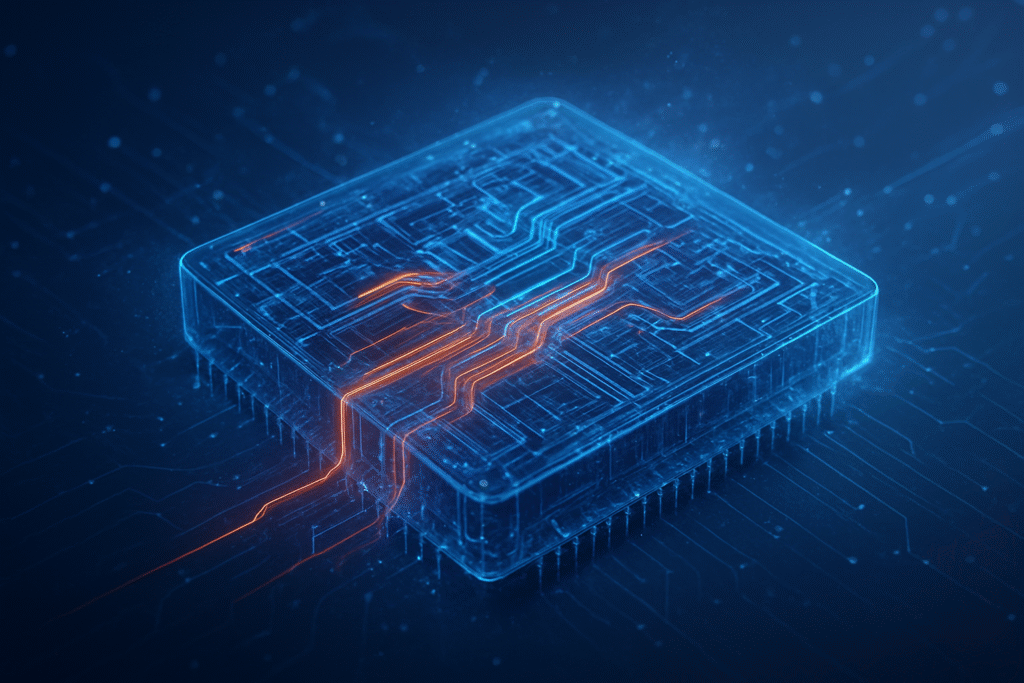
In a groundbreaking development poised to revolutionize semiconductor research and manufacturing, EuQlid has introduced its pioneering quantum imaging platform, Qu-MRI . This innovative technology offers unprecedented non-invasive 3D visualization of electrical currents within semiconductors and batteries, addressing a critical gap in existing metrology tools. By leveraging quantum magnetometry, Qu-MRI
. This innovative technology offers unprecedented non-invasive 3D visualization of electrical currents within semiconductors and batteries, addressing a critical gap in existing metrology tools. By leveraging quantum magnetometry, Qu-MRI promises to accelerate product development cycles, improve manufacturing yields, and unlock new possibilities for designing next-generation electronic devices.
promises to accelerate product development cycles, improve manufacturing yields, and unlock new possibilities for designing next-generation electronic devices.
The immediate significance of EuQlid's Qu-MRI cannot be overstated. As the tech industry pushes towards increasingly complex 3D architectures and advanced packaging in semiconductors—driven by the demands of artificial intelligence and high-performance computing—the ability to accurately map and understand sub-surface electrical activity becomes paramount. This platform provides direct, high-resolution insights into the intricate world of current flow, offering a powerful tool for engineers and researchers to diagnose issues, optimize designs, and ensure the reliability of advanced microchips.
cannot be overstated. As the tech industry pushes towards increasingly complex 3D architectures and advanced packaging in semiconductors—driven by the demands of artificial intelligence and high-performance computing—the ability to accurately map and understand sub-surface electrical activity becomes paramount. This platform provides direct, high-resolution insights into the intricate world of current flow, offering a powerful tool for engineers and researchers to diagnose issues, optimize designs, and ensure the reliability of advanced microchips.
Unveiling the Invisible: The Technical Prowess of Qu-MRI
EuQlid's Qu-MRI platform is a marvel of modern engineering, integrating quantum magnetometry with sophisticated signal processing and machine learning. At its heart are synthetic diamonds embedded with nitrogen-vacancy (NV) centers. These NV centers function as extraordinarily sensitive quantum sensors, capable of detecting the minute magnetic fields generated by electrical currents flowing within a device. The system then translates these intricate sensory readings into detailed, visual magnetic field maps, providing a clear picture of current distribution and flow.
platform is a marvel of modern engineering, integrating quantum magnetometry with sophisticated signal processing and machine learning. At its heart are synthetic diamonds embedded with nitrogen-vacancy (NV) centers. These NV centers function as extraordinarily sensitive quantum sensors, capable of detecting the minute magnetic fields generated by electrical currents flowing within a device. The system then translates these intricate sensory readings into detailed, visual magnetic field maps, providing a clear picture of current distribution and flow.
What sets Qu-MRI apart from conventional inspection methods is its non-contact, non-destructive, and high-throughput approach. Traditional techniques often involve destructive physical cross-sectioning or indirect electrical measurements, which can be time-consuming and limit the ability to analyze functioning devices. In contrast, Qu-MRI
apart from conventional inspection methods is its non-contact, non-destructive, and high-throughput approach. Traditional techniques often involve destructive physical cross-sectioning or indirect electrical measurements, which can be time-consuming and limit the ability to analyze functioning devices. In contrast, Qu-MRI boasts a remarkable resolution of one micron and nano-amp sensitivity, enabling the identification of subtle electrical anomalies and the precise mapping of sub-surface electrical currents. The integration of machine learning further enhances its capabilities, rapidly converting complex quantum sensing data into actionable insights, often within seconds. This allows for the precise mapping of buried current flow within complex, multi-layered 3D structures, a capability crucial for understanding dynamic electrical activity deep within advanced electronic components.
boasts a remarkable resolution of one micron and nano-amp sensitivity, enabling the identification of subtle electrical anomalies and the precise mapping of sub-surface electrical currents. The integration of machine learning further enhances its capabilities, rapidly converting complex quantum sensing data into actionable insights, often within seconds. This allows for the precise mapping of buried current flow within complex, multi-layered 3D structures, a capability crucial for understanding dynamic electrical activity deep within advanced electronic components.
Initial reactions from the semiconductor research community and industry experts have been overwhelmingly positive. The ability to directly visualize 3D charge flow, particularly in multi-layer chips with sub-micron feature sizes, fills a long-standing void where previous methods struggled with sensitivity, resolution, or were limited to 2D mapping. This breakthrough is seen as a foundational technology for controlling and optimizing intricate manufacturing workflows for advanced 3D architectures.
Reshaping the Semiconductor Landscape: Corporate Implications
The advent of EuQlid's Qu-MRI platform carries significant implications for a wide array of companies across the technology sector, from established tech giants to agile startups. Semiconductor manufacturers like Taiwan Semiconductor Manufacturing Company (TSMC: TPE) (NYSE: TSM), Samsung Electronics (KRX: 005930), and Intel Corporation (NASDAQ: INTC) stand to benefit immensely. The platform's ability to accelerate development cycles and improve manufacturing yields directly translates to reduced costs and faster time-to-market for their next-generation chips, particularly those leveraging advanced 3D packaging and backside power delivery.
platform carries significant implications for a wide array of companies across the technology sector, from established tech giants to agile startups. Semiconductor manufacturers like Taiwan Semiconductor Manufacturing Company (TSMC: TPE) (NYSE: TSM), Samsung Electronics (KRX: 005930), and Intel Corporation (NASDAQ: INTC) stand to benefit immensely. The platform's ability to accelerate development cycles and improve manufacturing yields directly translates to reduced costs and faster time-to-market for their next-generation chips, particularly those leveraging advanced 3D packaging and backside power delivery.
The competitive landscape in semiconductor metrology is poised for disruption. Existing metrology tool providers will need to adapt or integrate similar advanced capabilities to remain competitive. Companies involved in the design and fabrication of high-bandwidth memory, CPUs, and GPUs will find Qu-MRI invaluable for identifying and localizing interconnect errors and analyzing power flows within functioning devices. This technology offers a strategic advantage by providing unparalleled insights into device physics and failure mechanisms, allowing companies to refine their designs and manufacturing processes with greater precision.
invaluable for identifying and localizing interconnect errors and analyzing power flows within functioning devices. This technology offers a strategic advantage by providing unparalleled insights into device physics and failure mechanisms, allowing companies to refine their designs and manufacturing processes with greater precision.
Potential disruption extends to current quality control and failure analysis methodologies. By offering a non-destructive alternative, Qu-MRI could reduce the reliance on slower, more invasive techniques, thereby streamlining production lines and enhancing overall product quality. For startups focused on novel semiconductor architectures or advanced materials, this platform provides a powerful diagnostic tool, potentially accelerating their innovation cycles and enabling quicker validation of new designs. The market positioning for EuQlid itself is strong, as it addresses a multi-billion dollar global market for advanced metrology tools, aiming to make "quantum precision" available for both R&D labs and high-volume manufacturing environments.
could reduce the reliance on slower, more invasive techniques, thereby streamlining production lines and enhancing overall product quality. For startups focused on novel semiconductor architectures or advanced materials, this platform provides a powerful diagnostic tool, potentially accelerating their innovation cycles and enabling quicker validation of new designs. The market positioning for EuQlid itself is strong, as it addresses a multi-billion dollar global market for advanced metrology tools, aiming to make "quantum precision" available for both R&D labs and high-volume manufacturing environments.
Broader Significance: A New Era for Electronics
EuQlid's quantum imaging platform fits seamlessly into the broader AI landscape and the relentless pursuit of more powerful and efficient computing. As AI models grow in complexity, they demand increasingly sophisticated hardware, often relying on dense 3D integrated circuits. The ability to precisely visualize current flows within these intricate structures is not just an incremental improvement; it's a fundamental enabler for the next generation of AI accelerators and high-performance computing. This development marks a significant step towards fully understanding and optimizing the physical underpinnings of advanced electronics.
The impacts extend beyond semiconductors to other critical areas, notably the battery sector. Qu-MRI offers crucial insights into battery degradation pathways, paving the way for the development of safer, longer-lasting, and more efficient energy storage solutions—a vital component for electric vehicles, portable electronics, and renewable energy grids. This cross-sector applicability underscores the profound significance of EuQlid's technology.
offers crucial insights into battery degradation pathways, paving the way for the development of safer, longer-lasting, and more efficient energy storage solutions—a vital component for electric vehicles, portable electronics, and renewable energy grids. This cross-sector applicability underscores the profound significance of EuQlid's technology.
While the benefits are substantial, potential concerns might include the initial cost of adoption for such advanced quantum-based systems and the need for specialized expertise to fully leverage its capabilities. However, these are typical challenges with any revolutionary technology. Compared to previous AI and semiconductor milestones, such as the introduction of lithography or the development of FinFET transistors, Qu-MRI represents a breakthrough in characterization—the ability to see and understand what's happening at a fundamental level within these devices. This deeper understanding is crucial for overcoming current design and manufacturing bottlenecks, much like how advanced microscopy opened new fields in biology.
represents a breakthrough in characterization—the ability to see and understand what's happening at a fundamental level within these devices. This deeper understanding is crucial for overcoming current design and manufacturing bottlenecks, much like how advanced microscopy opened new fields in biology.
The Horizon: Future Developments and Applications
Looking ahead, the potential applications and use cases for EuQlid's quantum imaging platform are vast and varied. In the near term, we can expect its widespread adoption in advanced semiconductor R&D labs, where it will become an indispensable tool for debugging complex chip designs, validating new materials, and optimizing fabrication processes. Its role in high-volume manufacturing is also expected to grow rapidly, especially in quality control for critical components like high-bandwidth memory (HBM) and advanced logic chips, where even microscopic defects can lead to significant yield losses.
Long-term developments could see the integration of Qu-MRI data directly into AI-powered design automation tools, allowing for real-time feedback loops that optimize chip layouts based on actual current flow visualization. Experts predict that as the technology matures, its resolution and sensitivity could further improve, enabling even finer-grained analysis of quantum phenomena within devices. Furthermore, the platform's application in materials science could expand, allowing researchers to study the electrical properties of novel materials with unprecedented detail.
data directly into AI-powered design automation tools, allowing for real-time feedback loops that optimize chip layouts based on actual current flow visualization. Experts predict that as the technology matures, its resolution and sensitivity could further improve, enabling even finer-grained analysis of quantum phenomena within devices. Furthermore, the platform's application in materials science could expand, allowing researchers to study the electrical properties of novel materials with unprecedented detail.
Challenges that need to be addressed include further scaling the technology for even faster throughput in high-volume production environments and potentially reducing the cost of the quantum sensing components. Additionally, developing user-friendly interfaces and robust data analysis pipelines will be crucial for broader adoption beyond specialized research facilities. Experts predict that this technology will not only accelerate the development of next-generation semiconductors but also foster entirely new fields of research by providing a window into the previously invisible electrical world of micro- and nano-scale devices.
A New Era of Visibility in Electronics
EuQlid's introduction of the Qu-MRI quantum imaging platform marks a pivotal moment in the history of semiconductor and battery technology. The key takeaway is the establishment of a truly non-invasive, high-resolution, 3D visualization technique for electrical currents, a capability that has long eluded the industry. This development is not merely an improvement; it's a paradigm shift in how we understand, design, and manufacture advanced electronic components.
quantum imaging platform marks a pivotal moment in the history of semiconductor and battery technology. The key takeaway is the establishment of a truly non-invasive, high-resolution, 3D visualization technique for electrical currents, a capability that has long eluded the industry. This development is not merely an improvement; it's a paradigm shift in how we understand, design, and manufacture advanced electronic components.
Its significance in AI history is profound, as it directly enables the continued advancement of the hardware infrastructure upon which AI innovation relies. By providing unprecedented insights into the inner workings of complex chips, Qu-MRI will accelerate the development of more powerful, efficient, and reliable AI accelerators, ultimately pushing the boundaries of what artificial intelligence can achieve. The long-term impact will be seen in faster innovation cycles, higher product quality, and potentially entirely new device architectures that were previously impossible to characterize.
will accelerate the development of more powerful, efficient, and reliable AI accelerators, ultimately pushing the boundaries of what artificial intelligence can achieve. The long-term impact will be seen in faster innovation cycles, higher product quality, and potentially entirely new device architectures that were previously impossible to characterize.
In the coming weeks and months, industry observers should watch for further announcements regarding pilot programs with major semiconductor manufacturers, detailed case studies showcasing the platform's capabilities in real-world scenarios, and competitive responses from other metrology companies. EuQlid's Qu-MRI is set to become an indispensable tool, heralding a new era of visibility and precision in the ever-evolving world of electronics.
is set to become an indispensable tool, heralding a new era of visibility and precision in the ever-evolving world of electronics.
This content is intended for informational purposes only and represents analysis of current AI developments.
TokenRing AI delivers enterprise-grade solutions for multi-agent AI workflow orchestration, AI-powered development tools, and seamless remote collaboration platforms.
For more information, visit https://www.tokenring.ai/.




